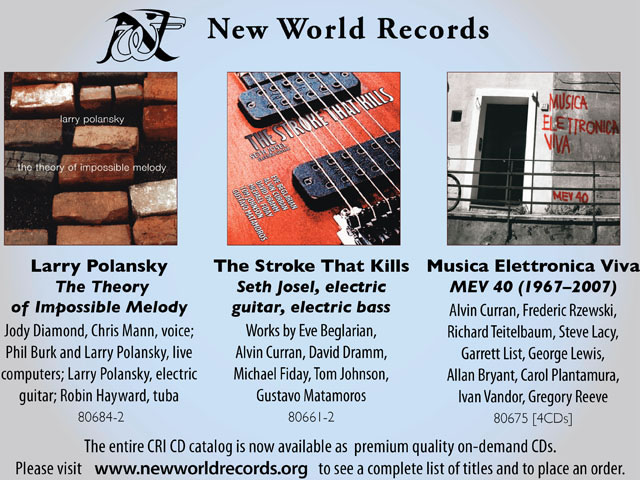Moment's Notice
Recent CDs Briefly Reviewed
(continued)
Gerald Cleaver + William Parker + Craig Taborn
Farmers by Nature
Aum Fidelity AUM053
 This lively collaborative trio, convened but not really led by drummer Gerald Cleaver, delights in free improvisations full of a remarkable variety of color, texture, energy, and melody. Yet despite the wide range and contrasts, the music never loses its coherence or sense of purpose. “The Night” develops a lovely improvised melody by Parker, with commentary and elaborations by Cleaver and Taborn; it’s a lyrical, airy passage in the continuous set to which to each player contributes equal parts rhythm and melody. “In Trees,” on the other hand, builds from a bouncing bass riff and then breaks free of the pattern, rushing and roiling like a snowmelt-fed river in spring. Parker, in an outstanding, vibrant performance, steers the trio more often than not. His improvising suggests possibilities for the rest of the trio while maintaining an integrity and logic all its own. But certainly everyone is listened to and supported and offers up suggestions and ideas that turn into fruitful directions for the band to explore. Cleaver makes consistently surprising choices on “Cranes,” abandoning any timekeeping duties for a while in favor of a conversational flow of sound that keeps the music spacious and supple; he then deploys overlapping layers of rhythms using the whole trap kit, energizing the rest of the band. Taborn thinks orchestrally as well, dropping a few notes here and there at the opening of “Not Unlike Number 10” before exploding into two-handed fusillades of chords and crashing sweeps up and down the keyboard. Like the farmers of the album’s title, this trio excels at planting kernels of sound and letting the music flower and flourish.
This lively collaborative trio, convened but not really led by drummer Gerald Cleaver, delights in free improvisations full of a remarkable variety of color, texture, energy, and melody. Yet despite the wide range and contrasts, the music never loses its coherence or sense of purpose. “The Night” develops a lovely improvised melody by Parker, with commentary and elaborations by Cleaver and Taborn; it’s a lyrical, airy passage in the continuous set to which to each player contributes equal parts rhythm and melody. “In Trees,” on the other hand, builds from a bouncing bass riff and then breaks free of the pattern, rushing and roiling like a snowmelt-fed river in spring. Parker, in an outstanding, vibrant performance, steers the trio more often than not. His improvising suggests possibilities for the rest of the trio while maintaining an integrity and logic all its own. But certainly everyone is listened to and supported and offers up suggestions and ideas that turn into fruitful directions for the band to explore. Cleaver makes consistently surprising choices on “Cranes,” abandoning any timekeeping duties for a while in favor of a conversational flow of sound that keeps the music spacious and supple; he then deploys overlapping layers of rhythms using the whole trap kit, energizing the rest of the band. Taborn thinks orchestrally as well, dropping a few notes here and there at the opening of “Not Unlike Number 10” before exploding into two-handed fusillades of chords and crashing sweeps up and down the keyboard. Like the farmers of the album’s title, this trio excels at planting kernels of sound and letting the music flower and flourish.
–Ed Hazell
Command All Stars
Curiosities 1972
Reel Recordings RR010
Harry Miller’s Isipingo
Full Steam Ahead
Reel Recordings RR012
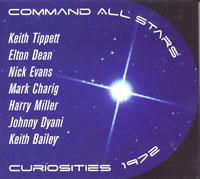 South African born bassist Harry Miller’s Isipingo released only one album during his life (there has been one previous posthumous release, Which Way Now on Cuneiform), so Full Steam Ahead is a welcome addition to a very thin recorded legacy. It’s also some of best music the band ever recorded. Culled from four different sessions made between February 1975 and November 1977, the album includes a date featuring pianist Stan Tracey subbing for regular pianist Keith Tippett, plus performances with the cast of Isipingo regulars, Mongezi Feza or Mark Charig on trumpet, Nick Evans or Malcolm Griffiths on trombone, Mike Osborne on alto saxophone, and Louis Moholo on drums.
South African born bassist Harry Miller’s Isipingo released only one album during his life (there has been one previous posthumous release, Which Way Now on Cuneiform), so Full Steam Ahead is a welcome addition to a very thin recorded legacy. It’s also some of best music the band ever recorded. Culled from four different sessions made between February 1975 and November 1977, the album includes a date featuring pianist Stan Tracey subbing for regular pianist Keith Tippett, plus performances with the cast of Isipingo regulars, Mongezi Feza or Mark Charig on trumpet, Nick Evans or Malcolm Griffiths on trombone, Mike Osborne on alto saxophone, and Louis Moholo on drums.
The sextet strikes an ideal balance between the melodic warmth and infectious groove of the South African music and the boundary pushing of British free jazz of the period. Miller is a big-hearted composer, he writes inviting melodies over dancing rhythms that the band can use, vary, or overturn as they see fit. Propelled by a beat pushed to the brink of freedom, “Children at Play” is replete with riffs that suggest melodic and rhythmic possibilities that liberate each soloist. “Good Heavens Evans” places a yearning melody over a free-floating rhythm, which encourages the soloists to play lyrically in a very free context. Moholo and Miller work hand-in-glove throughout, stating or implying the South African rhythms and allowing them to explicitly or subtly shape the tunes. The result is an electrifying album that straddles two musical worlds. To hear Charig sputtering and wailing on “Dancing Damon,” Osborne spurred on by Miller and Moholo to a wildly exhilarating solo on “Family Affair,” or Tracey’s impish chords goading Feza on “Whey Hey” is to hear those two worlds discovering, to their mutual surprise and delight, they had something to say to one another. It’s like two friends suddenly realizing they’re lovers.
South African émigrés such as Miller and Moholo were complete musicians, equally at ease with American jazz, South African popular and traditional music, and the latest developments of free jazz of the time. The crew of London improvisers they fell in with where just as enthusiastic about crossing musical borders as they were, so their work took many forms. In the case of the Command All Stars, it took the form of free improvisation that only rarely visits the townships as the musicians explore improvisatory interactions of many kinds. Recorded over three days in February 1972, this disc is all that remains of a projected two LP set featuring different groupings of players drawn from a pool that included Isipingo regulars Miller, Tippett, Evans, and Charig, along with Elton Dean, bassist Johnny Dyani, and drummer Keith Bailey.
The two great South African bassists are the heart of the music. On their long duet on “But Insane,” they sound positively eager and delighted to be working together. Dyani steals the show on “African Sunset” with a deep, thrumming sound and searching lyricism that overwhelms Miller’s noodling on African flute. On “African Sunrise,” the two bassists engage in a joyful spontaneous trio with Tippett on electric piano, who is clearly inspired by them. Even in the larger ensemble improvisation “Roots and Wings” the freedom and empathy of their interactions goad the rest of the ensemble to greater heights. Charig’s slim stabs and fat puffs of sound ricochet off them while Evans’ in-the-moment outbursts brim with excitement.
Miller, Moholo, Feza, and Dyani (as well as Chris McGregor and Dudu Pukwana) may have played with a South African accent, but they could play anything.
–Ed Hazell
Erik Friedlander
Broken Arm Trio
SKIPSTONE
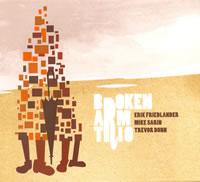 You’re worrying about the title? Relax, Erik’s not injured. Sixty years ago, Oscar Pettiford broke his arm playing baseball. He found he still had some mobility even with the sling, so he started practicing on a friend’s cello, retuned it, and quickly made it his own second voice. Ron Carter later took up the challenge, and doubled very effectively for a time, as did Ray Brown more briefly and Dollar Brand as well. For decades beginning in the ‘70s, there were few innovative exponents of jazz cello, Abdul Wadud, Hank Roberts and Ernst Reijseger foremost among them, but in recent years a few specialists have emerged, such Daniel Levin , Fred Lonberg-Holm and Nikos Veliotis, to pick just three representing stylistic extremes.
You’re worrying about the title? Relax, Erik’s not injured. Sixty years ago, Oscar Pettiford broke his arm playing baseball. He found he still had some mobility even with the sling, so he started practicing on a friend’s cello, retuned it, and quickly made it his own second voice. Ron Carter later took up the challenge, and doubled very effectively for a time, as did Ray Brown more briefly and Dollar Brand as well. For decades beginning in the ‘70s, there were few innovative exponents of jazz cello, Abdul Wadud, Hank Roberts and Ernst Reijseger foremost among them, but in recent years a few specialists have emerged, such Daniel Levin , Fred Lonberg-Holm and Nikos Veliotis, to pick just three representing stylistic extremes.
Erik Friedlander recognized his instrument’s potential in a jazz/improvising context when he heard Roberts with Arcado in the ‘80s. Roberts can be a scarifying player, bringing a touch of Schrei to the cello’s famously human vocalized sound. Friedlander restores much of that, but with an attractive discursiveness and plainness of delivery that means you don’t immediately think of Jacqueline Du Pré or Paul Tortelier when you encounter him on a record. Friedlander has a strong voice, in the Bloomish sense of one that, once encountered, ever afterwards has to be confronted and negotiated by fellow-practitioners and listeners alike . . .
. . . which makes the Broken Arm Trio particularly interesting in that Friedlander here concentrates on pizzicato playing. It’s busy, technically dazzling stuff much of the way. On” Ink,” he seems to satirize the kind of saurian stateliness of motion some critics profess (mystifyingly) to hear in jazz on the stringed instruments. There’s another blues, though, called “Tiny” (Grimes?), on which Friedlander returns to the guitar sound that remains one of his most basic and valuable musical resources; you have to remember that his dad Lee Friedlander did album covers for Atlantic’s R&B catalogue. “Spinning Plates” is at the other end of the spectrum, a demanding slice of neo-bop which calls for much more careful coordination of cello and double bass than most of the other tracks. The bassist is Trevor Dunn of Mr. Bungle, a background that’s immediately evident on the inspired nuttiness of “Jim Zipper.” At the kit, Mike Sarin sounds as easy and idiomatic as he did in the Thomas Chapin Trio or with bassist Mario Pavone. He’s a consistently underrated player, whose ability to imply melody even when rattling down an awkward 7/4 shape or doing his own whack version of four-to-the-floor is quite uncanny and provides the glue that holds this fairly recent but immensely cohesive group in shape. Outfits like this, Arcado, or the String Trio of New York, as I’ve argued before, meet with a certain resistant prejudice and yet in instrumentation (strings prominent) and approach (ensemble playing, collective improvisation, short features) stand very much closer to the Ur-texts of jazz than the horns-and-rhythm combos that peeled off from the swing bands and gave themselves to bop.
“Jazz cello’”still raises eyebrows, but sample this alongside Malaby’s Warblepeck and it’s hard to question its validity. Try a couple of Friedlander’s lines on a tenor saxophone: sounds good until you get to some of the trickier double-stops and it’s ‘”Put away that horn, boy . . . and don’t give me no shit about multiphonics. You’re beat.” Friedlander’s two previous records – the solo Volac for Tzadik and Block Ice and Propane for Skipstone – hatched in two quite different aspects of his creative personality. Broken Arm Trio somehow occupies a middle ground. Its occasional zaniness and almost deliberate crudity (on “Ink”) is matched by technique so breathtakingly effortless it takes a couple of listens to impinge properly. And after sixty years, it makes a very proper homage to Pettiford, who liked his new instrument so much he had his kid christened Cello.
–Brian Morton
Darren Johnston
The Edge of the Forest
Clean Feed CF133CD
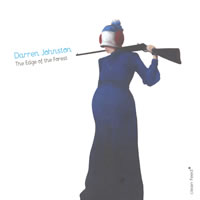 Darren Johnston is a Bay-area trumpeter who has studied at Mills College and has worked and recorded with some distinguished company, including Adam Lane and OrchestRova. He has previously recorded a single CD as leader, Reasons for Moving (NotTwo) with a quintet that included Fred Frith and Larry Ochs. While that recording placed an emphasis on improvisation, there’s a greater concentration on Johnston’s compositions here, executed here by his regular quintet – Ben Goldberg, clarinet; Sheldon Brown, bass clarinet and tenor; Devin Hoff, bass; and Smith Dobson V, drums.
Darren Johnston is a Bay-area trumpeter who has studied at Mills College and has worked and recorded with some distinguished company, including Adam Lane and OrchestRova. He has previously recorded a single CD as leader, Reasons for Moving (NotTwo) with a quintet that included Fred Frith and Larry Ochs. While that recording placed an emphasis on improvisation, there’s a greater concentration on Johnston’s compositions here, executed here by his regular quintet – Ben Goldberg, clarinet; Sheldon Brown, bass clarinet and tenor; Devin Hoff, bass; and Smith Dobson V, drums.
As both composer and trumpeter Johnston seems to come from some of the best places, Don Cherry and Booker Little, though the latter influence may be transmuted through Kenny Wheeler and Dave Douglas. Perhaps because of the quality of those forebears, Johnston already has his own sound and sense of form. The sound is tart, at times to the point of acidic, and it contributes to the intensity and focus of his lines, which are consistently probing, always reaching towards form. He can use mutes to touch on the timbres of early jazz as well as using extended techniques to stretch momentarily towards multiphonics. There’s a certain Klezmer-like quality to his compositions, often rooted in minor keys and emphasized by the sound of Goldberg’s dry clarinet. Added to that there’s a certain spikiness and jerkiness, a mix of the pensive and kinetic that can suggest both post-bop and the music of Hanns Eisler. There are frequent collisions in Johnston’s conflicting rhythms and figures, but that too is relieved by moments of lightly consonant swing.
Given the amount of thought that Johnston is clearly putting into his work, it’s a relief that it rarely sounds studied. The compositions act as triggers for consistently taut improvisation, from the rhythmic dance between horn and rhythm to improvised solo against composed ensembles to some stunning collective improvisations that—aided by Goldberg’s slithering clarinet--are joyous enough to suggest a free jazz take on New Orleans polyphony. Few musicians could get as much out of a small ensemble: the opening “Be the Frog” is filled with timbral contrasts, including the unison figures that rise to meet Johnston’s trumpet solo; “Foggy,” with the addition of Rob Reich’s accordion, effectively alternates lead voices against ensemble punctuations in a way that’s genuinely orchestral. Micro-groupings also figure in Johnson’s strategies, from an unaccompanied segment of clarinet and tenor to a pensive interlude of bass clarinet and string bass. Johnston even takes the unusual step of having the final “Sippin’ with Lou” end with the ensemble fading into silence until Brown’s wistful tenor is left starkly alone. It’s as beautiful as it is unlikely.
–Stuart Broomer
Sergey Kuryokhin
Absolutely Great!
Leo CD LR910/916
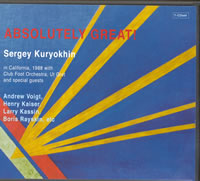 Sergey Kuryokhin had a relatively brief career. Born in 1954, he died in 1996 of myocardial sarcoma, a rare cancer of the heart. In that time he managed to distinguish himself as both an actor and a musician, whether as solo pianist, leader of the band Pop Mechanics or contributor to the Russian rock band Aquarium. His career as an improviser has been well-documented on Leo, including the sometimes startling solo CDs Some Combinations of Fingers and Passions and The Ways of Freedom, as well as a previous box set, Divine Madness. Absolutely Great! (the phrase was apparently Kuryokhin’s characteristic English sign of approval) is a seven-CD set recorded during his 1988 visit to California. Six of the CDs are previously unreleased live recordings from three nights’ performances. Each performance begins with an extended piano solo followed by a band performance with Kuryokhin joined by various assemblies of California musicians largely assembled by saxophonist and Rova charter member Andrew Voigt. The seventh CD is a series of studio duets with Henry Kaiser that was previously released on RykoDisk as Popular Science.
Sergey Kuryokhin had a relatively brief career. Born in 1954, he died in 1996 of myocardial sarcoma, a rare cancer of the heart. In that time he managed to distinguish himself as both an actor and a musician, whether as solo pianist, leader of the band Pop Mechanics or contributor to the Russian rock band Aquarium. His career as an improviser has been well-documented on Leo, including the sometimes startling solo CDs Some Combinations of Fingers and Passions and The Ways of Freedom, as well as a previous box set, Divine Madness. Absolutely Great! (the phrase was apparently Kuryokhin’s characteristic English sign of approval) is a seven-CD set recorded during his 1988 visit to California. Six of the CDs are previously unreleased live recordings from three nights’ performances. Each performance begins with an extended piano solo followed by a band performance with Kuryokhin joined by various assemblies of California musicians largely assembled by saxophonist and Rova charter member Andrew Voigt. The seventh CD is a series of studio duets with Henry Kaiser that was previously released on RykoDisk as Popular Science.
Given his technical brilliance and improvisatory freedom, Kuryokhin is no easy artist to classify. If Western audiences initially expected a kind of Russian Cecil Taylor, they would be confused if not disappointed, for Kuryokhin managed to be the opposite of both Taylor and his usual pole, Paul Bley. In some ways Kuryokin’s love of pastiche, parody and drama make him seem more like a Russian Frank Zappa without all the talking and notation. The solo portions of these performances place him deep in the tradition of European piano practice, and the manner might be termed stream of consciousness as much as improvisation. Kuryokin lights on a theme, usually diatonic and often highly melodic, then proceed to develop it in a quite traditional manner, employing variations on a theme. His technique can be stunning, and he seems to be working through the vocabularies, if not the specific themes, of composers from Tchaikovsky through Borodin and Mussorgsky to Scriabin and Stravinsky, using rapid chromatic transpositions and dizzying, end-to end runs to get from one theme to another. Fanfares and marches are frequent points of reference, and their very rigidity becomes both celebratory and comic in the face of Kuryokhin’s impetuous liberties (and liberty).
It’s a fun-house ride with distorting mirrors, and along the way there are moments of somber beauty, intense passion and profound feeling as well as much comedy, some of it broad and low. One of the analogues to Kuryokhin’s practice is the music of silent movie pianists, amplifying and exaggerating gestures that may already be sped up. It’s entertaining and liberating, a kind of vast suite in which the traditional preoccupations of classical music are jolted from tragedy to romance to farce. Rather than jazz, Kuryokhin’s improvisations might suggest the lost improvisations of Liszt, touched by 20th century anarchism.
The same mix of spontaneity, playfulness and sudden intense emotions that mark the Kuryokhin solos carry over to the band performances here. On the first of the three nights, recorded at the Noe Valley Ministry in San Francisco, he’s joined by a regular unit, the Club Foot Orchestra, a septet that included drummer Gino Robair and saxophonist Dave Barrett and a panoply of brass and reeds. It’s perhaps an ideal association, because the band is both tight-knit and ready to parody. The result is, oddly, as cinematic as the solo work, but it’s up-dated, resembling nothing so much as a Henry Mancini score that’s somehow been improvised by musical comedians, with analogues for everything from big-beat Peter Gunn and Pink Panther frivolity to bar-band rock and Maurizio Kagel marches. It’s great fun, even when heard on CD.
On the next night at Noe Valley Ministry, Kuryokhin’s solo transitions into an extended duet with Andrew Voigt, the two ranging through rhythmic minimalism a la Steve Reich, intense free jazz with overblown alto and moments of shakuhachi calm and duck-call comedy. The other performers for the night aren’t an organized band, but there’s a special consistency here, with several flute players as well as two largely unheard Shintaido martial artists. There’s at least one notated theme that blends Debussy-like calm with a gentle jungle ambience, heightened by the sweetness of the flutes, while cellist Boris Rayskin, an associate of Kuryokhin from St. Petersburg, contributes a sweeping Romanticism at the outset and later a wonderfully skewed hoe-down marked as well by guitarist Henry Kaiser’s contribution.
The third night’s ensemble, recorded at the Kuumbwa Jazz Center in Santa Cruz matches Kuryokhin and Voigt with Ut Gret, a classically-oriented quartet with Betsy Behnke and Joee Conroy on violins, Mark Bradlyn on viola and David Stilley on clarinets, the group supplementing their primary instruments with synthesizers and percussion and guitars. Boris Rayskin again appears among the guests and it’s a delight to hear how fluently the group can move from a kind of Webern-esque pointillism to klezmer and cabaret motifs, as well as some dramatic electronics. In one particularly fine moment there’s a strongly oriental string theme set against flamenco-like flourishes and bass clarinet grit. Elsewhere there a wonderfully shifting terrain that consists of multiple sliding guitar sounds and another mix of grandeur and kitsch that suggests a parody of Morricone.
The previously issued Popular Science is in sharp contrast to the wildly diffuse, sometimes meandering live performances. It consists of 19 tracks—mostly short and usually witty--and short tracks with Kuryokhin and Kaiser playing synclavier keyboards and Kaiser playing guitar as well. It’s consistently well-focused music by two insistently clever, highly resourceful musicians who exploit drum-programming and stack up plenty of layered keyboarding that’s insistent about its electronic source. There’s a piece called “Sugaguki #2 for Conlon,” for Nancarrow I assume, but the next track, “What Makes Shadows?” has passages that sound more like Nancarrow’s high-speed piano rolls. At times the CD sounds like robots throwing a party, but there are also moments of sudden and unexpected lyricism.
Kuryokhin could never be mistaken for a non-idiomatic improviser. He’s clearly taking far too much pleasure throughout these performances, a musician delighted to share in a common thematic inheritance with a bevy of fresh faces as they mirthfully hit upon, gather around to celebrate and destroy the familiar joys and irritating banalities of a host of idioms. It’s a world in which reflection and cartoon constantly impinge on one another. Clearly his days in California were a special occasion for the other musicians as well as for Kuryokhin himself.
–Stuart Broomer
